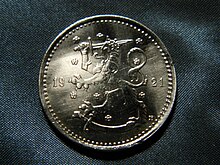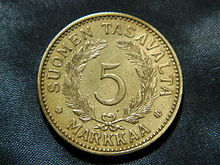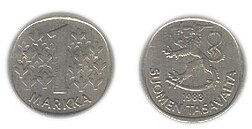 1 mk, 1983 1 mk, 1983 | |
| ISO 4217 | |
| Code | FIM |
| Unit | |
| Plural | markkaa (Finnish partitive sg.) mark (Swedish) |
| Symbol | mk |
| Denominations | |
| Subunit | |
| 1⁄100 | penni |
| Plural | |
| penni | penniä (Finnish partitive sg.) penni (Swedish) |
| Symbol | |
| penni | p |
| Banknotes | |
| Freq. used | 10 mk, 20 mk, 50 mk, 100 mk, 500 mk |
| Rarely used | 1000 mk |
| Coins | |
| Freq. used | 10p, 50p, 1 mk, 5 mk, 10 mk |
| Rarely used | 1p (until 1979), 5p and 20p (until 1990) |
| Demographics | |
| Date of introduction | 1860 |
| Replaced | Ruble |
| Replaced by | Euro |
| User(s) | None, previously:
|
| Issuance | |
| Central bank | Bank of Finland |
| Website | www |
| Valuation | |
| Inflation | 1.3% |
| Source | CIA World Factbook 2001 |
| EU Exchange Rate Mechanism (ERM) | |
| Since | 14 October 1996 |
| Fixed rate since | 31 December 1998 |
| Replaced by euro, non cash | 1 January 1999 |
| Replaced by euro, cash | 1 March 2002 |
| 1 € = | 5.94573 mk |
| This infobox shows the latest status before this currency was rendered obsolete. | |
The markka (Finnish: markka; Swedish: mark; sign: mk; ISO code: FIM), also known as the Finnish mark, was the currency of Finland from 1860 until 28 February 2002, when it ceased to be legal tender. The markka was divided into 100 pennies (Finnish: penni; Swedish: penni), abbreviated as "p". At the point of conversion, the rate was fixed at €1 = 5.94573 mk.
The markka was replaced by the euro (€), which had been introduced, in cash form, on 1 March 2002. This was after a transitional period of three years, when the euro was the official currency but only existed as "book money" outside of the monetary base. The dual circulation period, when both the markka and the euro had legal tender status, ended on 28 February 2002.
Etymology
The name "markka" was based on a medieval unit of weight. Both "markka" and "penni" are similar to words used in Germany for that country's former currency, based on the same etymological roots as the Deutsche Mark and pfennig.
Although the word "markka" predates the currency by several centuries, the currency was established before being named "markka". A competition was held for its name, and some of the other entries included "sataikko" (meaning "having a hundred parts"), "omena" (apple) and "suomo" (from "Suomi", the Finnish name for Finland).
The Finnish language does not use plurals when referring to multiple markkaa, but partitive singular forms: "10 markkaa" and "10 penniä" (the nominative is penni). In Swedish, the singular and plural forms of "mark" and "penni" are the same.
Nicknames
When the euro replaced the markka, mummonmarkka (lit. 'grandma's markka', sometimes shortened to just mummo) became a new colloquial term for the old currency. The sometimes used "old markka" can be misleading, since it can also be used to refer to the pre-1963 markka. In Helsinki slang, the sum of a hundred markkaa was traditionally called a huge (from Swedish hundra for "hundred"). After the 1963 reform, this name was used for one new markka.
History


 5 mk banknote of the Grand Duchy of Finland (1897)
5 mk banknote of the Grand Duchy of Finland (1897)
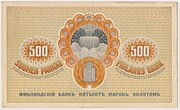
 500 mk banknote of the Grand Duchy of Finland (1909)
500 mk banknote of the Grand Duchy of Finland (1909)
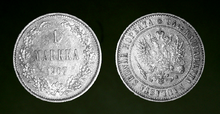
During its time as a grand duchy under the Russian empire, Finland used the Russian rouble and the riksdaler of its former parent country Sweden as concurrent currencies until the currency redefinition in 1840. After this Finland used the Russian rouble as its sole currency for two decades.
The markka was introduced in 1860 by the Bank of Finland, replacing the Russian ruble at a rate of four markkaa to one ruble.
Senator Fabian Langenskiöld is called "father of the markka". In late 1859, on Langenskiöld's initiative the Senate of Finland made a proposition to the Emperor that banknotes of the Russian rouble would no longer be used for their face value in Finland, but instead for their real price, which would be defined at the stock market in St. Petersburg. The reason for this was instability caused by the Crimean War, which had caused the Bank of Finland to stop exchanging its rouble banknotes for silver. Finland asked the Emperor for permission for a currency of its own and got the permission on 4 April 1860, when Emperor Alexander II of Russia signed the Merciful announcement by his Imperial Majesty for a new currency for the Grand Duchy of Finland. The markka was taken into use in 1860, but its value was tied to the Russian rouble: one markka equalled one quarter of a rouble, but there was speculation in Russia that even that was too much of a value for the new currency.
Both Fabian Langenskiöld who acted as the head of the finance office of the Senate of Finland from 1858 to 1863 and his successor Johan Vilhelm Snellman have been called "the father of the markka". The markka was taken into use in Langenskiöld's time, but its separation from the Russian rouble fell to Snellman. In 1862 Langenskiöld had received acceptance from the Emperor for his plan to have the markka coins as Finland's only legal tender and give the Bank of Finland the right to accept its banknotes for their face value. The implementation of this plan fell to Snellman after Langenskiöld's death in summer 1863.
A loan was necessary for the birth of the markka, as accepting banknotes would only be possible if there was enough silver in the vault of the Bank of Finland. This loan was received from the powerful banker Carl Mayer von Rotschild. This was Finland's first loan from the western finance market.
In 1865, the markka was separated from the ruble and tied to the value of silver, becoming an independent currency. From 1878 to 1915, Finland adopted the gold standard of the Latin Monetary Union.
In 1878 the markka was tied to a gold standard, and 20 markkaa corresponded to 6.45 grams of a mixture containing 900 per mille of pure gold. The markka was of equal value with the French franc, the Belgian franc, the Swiss franc and the Italian lira (and later also with other member states of the so-called Latin Monetary Union). The size, weight and gold content of these coins was equal regardless of the issuing country and in theory, they were also legal tender regardless of the issuing country, even though gold 10 and 20 markkaa coins were struck in so small amounts compared to the other corresponding European coins that no significant numbers of these coins ever wound up in central Europe.
Before World War I the legal tender in Finland was gold markka coins, of which quite few were actually in circulation. On the other hand, banknotes issued by the Bank of Finland were not legal tender. This meant that a creditor had to accept Finnish gold coins as payment, but was under no obligation to accept banknotes, even though these could be exchanged for gold coins. In practice however everyone also accepted payment in banknotes.
Up until World War I, the value of the markka fluctuated within +23%/−16% of its initial value, but with no trend. The markka suffered heavy inflation (91%) during 1914–18. Gaining independence in 1917, Finland returned to the gold standard from 1926 to 1931. While prices remained stable until 1940, the markka suffered heavy inflation (17% annually on average) during World War II and again in 1956–57 (11%). In 1963, in order to reset the inflation, the markka was redenominated and replaced by a new markka worth 100 old markkaa.
Finland joined the Bretton Woods Agreement in 1948. The value of the markka was pegged to the dollar at 320 mk = US$1, which became New 3.20 mk = US$1 in 1963 and devalued to 4.20 mk = US$1 in 1967. After the breakdown of the Bretton Woods agreement in 1971, a basket of currencies became the new reference. Inflation was high (over 5%) during 1971–85. Occasionally, devaluation was used, 60% in total between 1975 and 1990, allowing the currency to more closely follow the depreciating US dollar than the rising German mark. The paper industry, which mainly traded in US dollars, was often blamed for demanding these devaluations to boost their exports. Various economic controls were removed and the market was gradually liberalized throughout the 1980s and the 1990s.
The monetary policy called "strong markka policy" (vahvan markan politiikka) was a characteristic feature of the 1980s and early 1990s. The main architect of this policy was President Mauno Koivisto, who opposed floating the currency and devaluations. As a result, the nominal value of the markka was extremely high, and in the year 1990, Finland was nominally the most expensive country in the world according to OECD's Purchasing Power Parities report.
Koivisto's policy was maintained only briefly after Esko Aho was elected Prime Minister. In 1991, the markka was pegged to the currency basket ECU, but the peg had to be withdrawn after two months with a devaluation of 12%. In 1992, Finland was hit by a severe recession, the early 1990s depression in Finland. It was caused by several factors, the most severe being the incurring of debt, as the 1980s economic boom was based on debt. Also, the Soviet Union had collapsed, which brought an end to bilateral trade, and existing trade connections were severed. The most important source of export revenue, Western markets, were also depressed during the same time, in part due to the war in Kuwait. As a result, by some opinions years overdue, the artificial fixed exchange rate was abandoned and the markka was floated. Its value immediately decreased 13% and the inflated nominal prices converged towards German levels. In total, the value of the markka had decreased 40% as a result of the recession. Also, as a result, several entrepreneurs who had borrowed money denominated in foreign currency suddenly faced insurmountable debt.
Inflation was low during the markka's independent existence as a floating currency (1992–1999): 1.3% annually on average. The markka was added into the ERM system in 1996 and then became a fraction of the euro in 1999, with physical euro money arriving later in 2002. It has been speculated that if Finland had not joined the euro, market fluctuations such as the dot-com bubble would have reflected as wild fluctuations in the price of the markka. Nokia, formerly traded in markka, was in 2000 the European company with the highest market capitalization.
Coins
First markka

When the markka was introduced, coins were minted in copper (1, 5 and 10 penniä), silver (25p and 50p, 1 mk and 2 mk) and gold (10 mk and 20 mk). The first markka coins were designed by the Russian artist Alexander Fadeyev. The first coin stamps for the markka coins were carved by the carver of the Mint of Finland Lea Ahlborn in 1863. The Mint of Finland started operating right after its premises were completed in Katajanokka, Helsinki in autumn 1864, and the first silver markka coins were struck on 15 October 1864.
When the markka was tied to silver in 1865, markka coins were struck for "94.48 pieces for a pound of clear silver", meaning that a pound of silver gave 94.48 markka coins. "Full-value" coins of 1 and 2 markkaa were struck from a mixture containing 868 per mille of silver. The mixture used for penni coins contained 750 per mille of silver.
When the markka was tied to gold in 1877, coins of 10 and 20 markkaa were struck in gold. They were made from a mixture containing 90% of gold and 10% of copper. The gold 20 markkaa coin (6.45 g) contained 5 and 25/31 grams of pure gold, the rest was copper. The 10 markkaa coin contained gold of half of this amount, i.e. 2 and 28/31 grams of pure gold.
After the First World War, silver and gold issues were ceased and cupro-nickel 25p and 50p and 1 mk coins were introduced in 1921, followed by aluminium-bronze 5 mk, 10 mk and 20 mk between 1928 and 1931. During the Second World War, copper replaced cupro-nickel in the 25p and 50p and 1 mk, followed by an issue of iron 10p, 25p and 50p and 1 mk. This period also saw the issue of holed 5p and 10p coins.
All coins below 1 markka had ceased to be produced by 1948. In 1952, a new coinage was introduced, with smaller iron (later nickel-plated) 1 mk and 5 mk coins alongside aluminium-bronze 10 mk, 20 mk and 50 mk coins and (from 1956) silver 100 mk and 200 mk denominations. This coinage continued to be issued until the introduction of the new markka in 1963.
Second markka
The old coins and banknotes were exchanged to new ones at 100:1 rate.
First series
The new markka coinage consisted initially of six denominations: 1 (bronze, later aluminium), 5 (bronze, later aluminium), 10 (aluminium-bronze, later aluminium), 20 and 50 penniä (aluminium-bronze) and 1 markka (silver, later cupro-nickel). The design of new coins (1963) was identical to those of the last issue of the old markka but with new denominations (i.e. 1 penni instead of 1 markka, etc.).
From 1972, aluminium-bronze 5 mk were also issued.
Second series
The last series of Finnish markka coins included five coins (listed with final euro values, rounded to the nearest cent):
- 10p (cupronickel) – a honeycomb on the reverse and a lily of the valley flower on the obverse = €0.02
- 50p (cupronickel) – haircap moss on the reverse and a bear on the obverse = €0.08
- 1 mk (aluminum-bronze) – the Finnish coat of arms on the reverse = €0.17
- 5 mk (aluminum-bronze) – a lily pad leaf and a dragonfly on the reverse and a Saimaa seal on the obverse = €0.84
- 10 mk (bimetallic coin, aluminum-bronze centre and cupronickel ring) – rowan tree branches and berries on the reverse and a wood grouse on the obverse = €1.68
Banknotes
This section covers the last design series of the Finnish markka, designed in the 1980s by Torsten Ekström [fi] and Finnish designer Erik Bruun and issued in 1986.
| Denomination | Value in euros (€) | Image | Main colour | Obverse | Reverse | Remark | |
|---|---|---|---|---|---|---|---|
| 10 mk | €1.68 | 
|

|
Blue | Paavo Nurmi (1897–1973), athlete and Olympic winner | Helsinki Olympic Stadium | Discontinued upon the introduction of the 20 mk note in 1993. |
| 20 mk | €3.36 | 
|
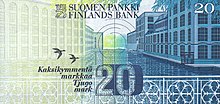
|
Aqua | Väinö Linna (1920–1992), author and novelist | Tammerkoski | Introduced in 1993 to replace the 10 mk note. |
| 50 mk | €8.41 | 
|

|
Brown | Alvar Aalto (1898–1976), architect | Finlandia Hall | |
| 100 mk | €16.82 | 
|
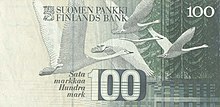
|
Green | Jean Sibelius (1865–1957), composer | Whooper swans | |
| 500 mk | €84.09 | 
|

|
Red | Elias Lönnrot (1802–1884), compiler of Kalevala | Forest hiking trail | |
| 1,000 mk | €168.19 | 
|
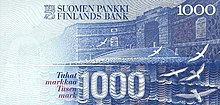
|
Purple | Anders Chydenius (1729–1803), priest and statesman | Kuninkaanportti gate in Suomenlinna | |
| 5,000 mk | €840.94 | Pink | Mikael Agricola (1510–1557), priest and linguist (based on the statue by Oskari Jauhiainen [fi] in front of Turku Cathedral) | Turku Cathedral | The note was never introduced. It was only a backup plan for inflation. | ||
In this final banknote series, the Bank of Finland used a photograph of Väinö Linna on the 20 mk note without permission from copyright holders. This was only revealed after several million notes were in use. The Bank paid 100,000 mk (€17,000) compensation to the rights holders.

The second-to-last banknote design series, designed by Tapio Wirkkala, was introduced in 1955 and revised in the reform of 1963. It was the first series to depict actual specific persons rather than allegorical figures. These included Juho Kusti Paasikivi on the 10 mk, K. J. Ståhlberg on the 50 mk, J. V. Snellman on the 100 mk and, controversially, Urho Kekkonen on the 500 mk, added in 1975 to commemorate the president's 75th birthday. Unlike Erik Bruun's series, this series did not depict any other real-life subjects, but only abstract ornaments in addition to the depictions of people. A popular joke at the time was to cover Paasikivi's face except for his ear and back of the head on the 10 mk note, ending up with something resembling a mouse, said to be the only animal illustration in the entire series.
The still-older notes, designed by Eliel Saarinen, were introduced in 1922. They also depicted people, but these were generic men and women, and did not represent any specific individuals. The fact that these men and women were depicted nude caused a minor controversy at the time.
Euro banknotes
By the end of 2001, Finland was a relatively cashless society. Most transactions were paid either using the 100 mk banknote or by debit card. There were 4 million banknotes apiece of the 500 mk and 1,000 mk denomination banknotes for a country with a population of over 5 million people. There were about 19 banknotes per individual of the smaller denomination, adding up to €241 per inhabitant. For the introduction of the euro, ECB produced €8,020 million in banknotes before the changeover.
During the first weeks of 2002, Finland's replacement of previous national banknotes with euro banknotes was among the fastest in the euro area. Of the cash payments, three-fourths were paid in euro already at the end of the first changeover week. Coins and banknotes that were legal tender at the time of the markka's retirement could be exchanged for euros until 29 February 2012. Today, the only value that markka coins and banknotes have is their value as collectibles.
See also
- Bank of Finland
- Scandinavian Monetary Union
- Finnish euro coins
- Economy of Finland
- History of money in Finland
References
- "The home of the Unicode Common Locale Data Repository". github.com. Unicode. li. 6823. Retrieved 21 July 2024.
- ^ Kuusterä, Antti: Oravannahasta sirukorttiin - jäähyväiset markalle. Accessed on 14 September 2012.
- "Pankinjohtaja Sinikka Salon puhe Snellman ja Suomen markka -näyttelyn avajaisissa Suomen Pankin rahamuseossa". Suomen Pankki. 10 January 2006. Retrieved 9 December 2017.
- ^ Nurmi, Esko: Markan oikea isä ei ollut Snellman. Helsingin Sanomat 6 December 2001.
- Pankinjohtaja Sinikka Salon puhe Snellman ja Suomen markka -näyttelyn avajaisissa Suomen Pankin rahamuseossa, Bank of Finland 10 January 2006. Accessed on 9 December 2017.
- Kuisma, Markku; Keskisarja, Teemu: Erehtymättömät, pp. 18-19. Helsinki, WSOY 2012. ISBN 978-951-0-39228-7.
- Klinge, Matti. "Snellman, Johan Vilhelm (1806 - 1881)". The National Biography of Finland. Retrieved 24 November 2017.
- ^ Carl-Ludwig Holtfrerich, Jaime Reis, and Gianne Toniolo, The Emergence of Modern Central Banking from 1918 to the Present, table 4.2
- ^ "Rahanarvonkerroin 1860–2016". Statistics Finland. 2017. Retrieved 29 December 2019.
- Schienstock, Gerd (January 2004). Embracing the knowledge economy: The dynamic transformation of the Finnish innovation system. p. 34. doi:10.4337/9781843769811. ISBN 9781843769811.
- Genberg, Hans: Monetary Policy Strategies after EU Enlargement Archived 2013-05-14 at the Wayback Machine. Graduate Institute of International Studies, Geneva, Switzerland, 2 February 2004. Accessed 7 February 2009.
- "Archived copy". Archived from the original on 13 October 2013. Retrieved 6 October 2013.
{{cite web}}: CS1 maint: archived copy as title (link) - "Finnish Consumer Prices are the highest in OECD". Wall Street Journal. 14 January 1992.
- Salo, Sinikka: Katoaako käteisraha maksamisen välineenä? In Katajanokan Kaiku 2024, publications of the Katajanokka Society, pp. 26-28.
- Historia, Mint of Finland. Accessed on 23 September 2015.
- 1mk 1864 - 1915, kolikot.com. Accessed on 1 October 2007.
- 2mk 1864 - 1917, kolikot.com. Accessed on 1 October 2007.
- 20mk 1878 - 1913, kolikot.com. Accessed on 1 October 2007.
- Pieni tietosanakirja, 3rd edition, p. 603. Article "Raha" ("Money"). Otava, 1927.
- Friedberg, Arthur L.; Friedberg, Ira S. (2009). Gold Coins of the World: From Ancient Times to the Present : an Illustrated Standard Catalogue with Valuations. Coin & Currency Institute. pp. 212–213. ISBN 978-0-87184-308-1.
- Heiko, Otto. "Historical banknotes from Finland". Retrieved 28 December 2019.
- "Pois työpöydältä: 5000 markan seteli". 2012.
- "Book launch of 'The last markka banknotes' and a new exhibition at the Bank of Finland Museum".
- Kaartamo, Outi: Raha on kaunista. Helsingin Sanomat monthly supplement, April 2010, pp. 83–88.
- Luukka, Teemu (27 September 2006). "Suomen Pankki maksoi korvauksia valokuvasta 17 000 euroa" (in Finnish). HS. Retrieved 2 October 2006.
- "Finland's Most Beautiful Banknote Chosen". April 2011.
- Historical Finnish banknotes and coins, Bank of Finland. Accessed on 20 December 2020.
- "Bank of Finland Annual Report 2002" (PDF). p. 29. Retrieved 7 September 2019.
External links
- Overview of markka from the BBC
- Historical Finnish banknotes and coins at the Bank of Finland
- Main outlines of Finnish history – thisisFINLAND
- History of the Finnish Markka (1860–2002)
- Historical banknotes from Finland (in English and German)
| Preceded byRussian ruble | Finnish currency 1860–2002 |
Succeeded byeuro |
| Currencies named mark or similar | |
|---|---|
| Circulating |
|
| Defunct | |
| As a denomination | |
| Euro topics | |||||||||
|---|---|---|---|---|---|---|---|---|---|
| General | |||||||||
| Administration | |||||||||
| Fiscal provisions | |||||||||
| Economy | |||||||||
| International status | |||||||||
| Denominations |
| ||||||||
| Coins by country with minting rights |
| ||||||||
| Non-EU territories using euro per agreement without minting rights | |||||||||
| Potential adoption by other countries | |||||||||
| Countries and territories using euro unilaterally | |||||||||
| Other extant EU currencies |
| ||||||||
| History |
| ||||||||
| Finland articles | |||||
|---|---|---|---|---|---|
| History | |||||
| Geography | |||||
| Politics | |||||
| Economy | |||||
| Society |
| ||||
